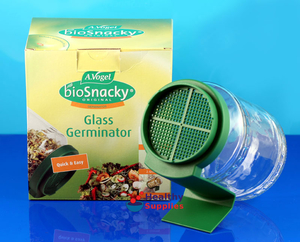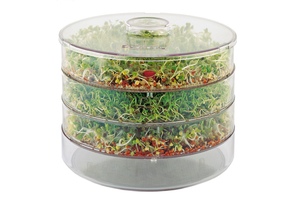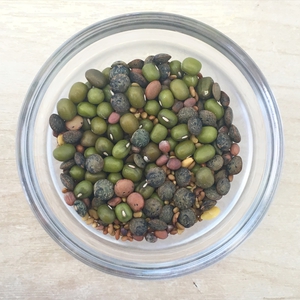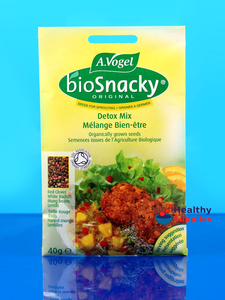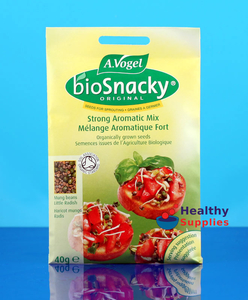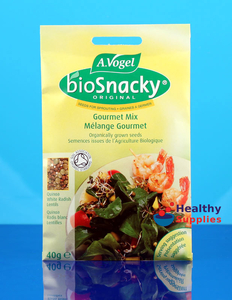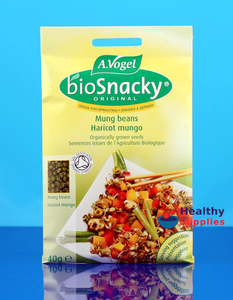STEP-BY-STEP GUIDE TO SPROUTING
Sprouting is a fantastic way to get added nutrients, vitamins and minerals into your diet. These tiny shoots are packed with goodness and really couldn’t be easier to grow. We stock many different types of sproutable seeds and pulses, as well as the vessels required for growing them!
Sprouts can be used in both sweet and savoury recipes. We love sprinkling our homegrown sprouts over salads, into sandwiches and into stir fries.
This month we tried and tested some of our most popular sprouting seed mixes.
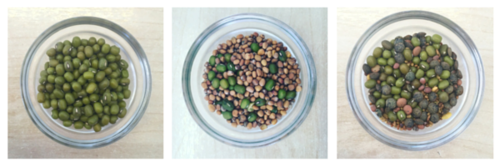
Our germinator jar is our most popular sprouting vessel. It has enough space to grow one type of seeds. Each harvest yields a very generous amount of sprouts. More than enough for two people for a couple of days. It comes with a handy screw top lid that allows for easy rinsing and drainage. it doesn’t take up much room and can sit happily on a window ledge or desk.
The 3 Tier Germinator is our super-sized germinator. Perfect for families, colleagues or housemates. The generously-sized trays provide ample space for your sprouts. It gives you the choice of filling all trays at the same time or alternating your harvests so you have a constant supply of your favourite sprouts. There is a handy drainage system that allows the sprouts to be evenly rinsed and drained. We love the choices that this germinator gave us.
We used four of our most popular seed packets. These included our detox mix, strong aromatic mix, gourmet mix and mung beans. All of the seeds had slightly different sprouting times but generally we found that we could harvest them within 5 days. It was amazing how quickly these little guys grew!
The detox mix contained a variety of different seeds and pulses including: Red Clover seeds, White Radish, Mung Beans and Lentils.
The strong aromatic mix contained White Radish and Mung Beans.
The Gourmet Mix makes the most of the nutrients offered by the combination of Rocket, White Radish and Lentil.
The Mung Bean is probably the first sprouted ‘seed’ that most people have eaten, without even realising it. Chinese bean sprouts, common in stir-frys and spring rolls are actually mung sprouts that have grown on just a little further than ones that are usually eaten as part of a sprouting mix. Mung Bean sprouts contain the following vitamins: A, B1, B2, B3, B12 and vitamin C. In addition to this there is plenty of iron, potassium, calcium, magnesium and phosphorus. This really makes it an essential bean to include in a healthier diet.
Soaking your seeds is a really important step on your sprouting journey. An overnight soak speeds up the germination of a seed, meaning the sprouting process is faster. With the germinator jar, we simply added the seeds to the glass jar and topped up with water. We left it standing upright overnight. With the 3 tier germinator, we soaked our seeds in some glass dishes.
We saw little activity on the seeds by day two. The seeds in the germinator jar were easily drained by attaching the lid and tipping the jar upside down over a sink. We then gave the seeds another quick rinse before turning onto the stand. The 3 tier germinator jar seeds were drained and rinsed. We then sowed the seeds evenly over the three tiers.
By day three there was significant activity with our little sprouts. Honestly we were amazed by how quickly these little seeds and pulses popped into action. All we needed to do was rinse and drain the sprouts twice a day. This process can seem a bit fiddly at first, but if you set up the tiers in the right way it can be kind of theraputic. The trick is to arrange the red drainage spouts on opposite sides. Fill the water so the seeds are covered, then tilt the water towards the red spout. This will cause the water to trickle out and into the next layer. Repeat the process until the water has rinsed and drained from all the layers.
You should see a significant amount of activity on this day. Again all you need to do is rinse and drain twice a day. Some of our mung beans were actually ready on day four. We were half expecting them to turn into thick chunky bean sprouts – as you see in the supermarket. But these were more elegant and slimmer. They had a subtle sweetness to them. Delicious.
This was the day to harvest our sprouts. By this point we were pros at the whole rinse and draining process. Our sprouts had morphed into a glorious forest of fluffy tendrils and vibrant little leaves. I was really happy with how many sprouts a tablespoon of seeds produced. The jar was packed full of sprouts as was the 3 tier germinator. More than enough sprouts for the whole Healthy Supplies team.
Reaping what you sow! But don't over-sprout.
I found thats our sprouts were all definetly ready by day five. The sprouts were still edible on the sixth day but they had grown bigger leaves and some of them had developed a bitter taste. Worth taking note that if your sprouts have these pretty bigger leaves, you have left them to sprout for too long.

